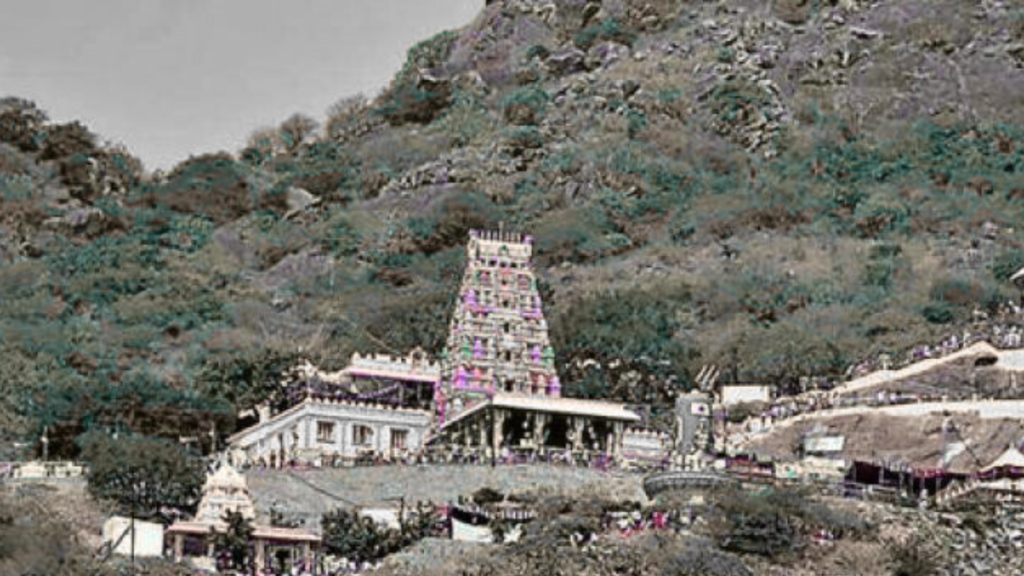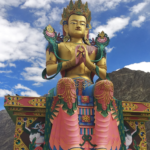Nestled in the hills of Palnadu district, Andhra Pradesh, Kotappakonda Sri Trikoteswara Swami Temple is a sacred haven dedicated to Lord Shiva. Perched atop a three-peaked hill called Trikutadri, this temple draws devotees and travelers with its divine aura and stunning views. The name Trikoteswara comes from the trio of hills—Brahma, Vishnu, and Maheswara—symbolizing Hinduism’s holy trinity. Whether you’re climbing its 1,000 steps or driving the ghat road, the journey feels like a pilgrimage to peace. Famous for its grand Mahashivratri festival, the temple buzzes with lakhs of devotees, colorful prabhas, and vibrant fairs. Its history stretches back to the 12th century, with renovations by local kings adding to its glory. In this article, I’ll guide you through the temple’s history, rituals, travel tips, and why it’s a must-visit for anyone seeking blessings or beauty.
The Spiritual Heart of Trikutadri
Kotappakonda’s magic lies in its setting atop Trikutadri, a hill with three peaks representing Brahma, Vishnu, and Shiva. The main temple, on Brahma Shikharam at 600 feet, houses a powerful Shiva Lingam radiating serenity. Devotees believe the trinity fulfills wishes of those who visit with pure hearts. The temple’s spiritual vibe, paired with panoramic views of lush hills, makes it a place for both prayer and peace. From the rhythmic chants of priests to the fragrance of bilva leaves, every moment feels holy. Whether you’re a devotee or a curious traveler, the temple’s energy and natural beauty leave you refreshed and inspired.
Legend of Gollabhama’s Devotion
A beautiful tale surrounds the temple. Long ago, a devotee named Gollabhama (or Anandavalli) worshipped Shiva daily at the old temple on Rudra Shikharam. Her devotion was so pure that Shiva, moved by her penance, appeared as Jangama Devara. When she broke a promise by turning back, he transformed into a Lingam on Brahma Shikharam, creating the new Trikoteswara Temple. Devotees visit Gollabhama’s shrine first, honoring her faith. This story adds a heartfelt layer to the temple’s spiritual pull.
The Trinity’s Sacred Presence
The three peaks of Trikutadri make Kotappakonda unique. Named Brahma, Vishnu, and Maheswara, they embody creation, preservation, and destruction. The main temple on Brahma Shikharam is the heart, but Paata Kotayya Temple on Rudra Shikharam and Papanaseshwara Temple on Vishnu Shikharam add to the divine complex. Devotees feel the trinity’s power in every step, believing the hills amplify prayers. This sacred trio makes the temple a magnet for those seeking guidance or blessings, blending faith with the hills’ natural majesty.
A Glimpse into the Temple’s History
Kotappakonda’s history dates back before 1172 AD, with inscriptions hinting at its ancient roots. The temple, as we see it today, was built in 1761 by Raja Malraju Narasimha Rayulu, a Narasaraopet landlord. Kings like Krishnadevaraya and Chola rulers supported it, donating land and resources. The temple’s growth reflects the faith of locals and rulers alike, with zamindars ensuring its upkeep. From its humble origins to its current grandeur, Kotappakonda stands as a testament to centuries of devotion, blending myth, history, and culture in every stone.
Ancient Origins and Royal Support
Records suggest the temple existed in the 12th century, possibly earlier, tied to Vedic traditions. Chola king Kulothunga and local lords left inscriptions, proving its age. Vijayanagara rulers, like Krishnadevaraya, gifted land to sustain it. In 1761, Raja Malraju Narasimha Rayulu rebuilt it, adding 703 steps for pilgrims. Narasaraopet’s zamindars, as permanent trustees, ensured its care. This royal backing turned Kotappakonda into a major pilgrimage site, preserving its spiritual and cultural legacy for generations.
Mythical Tales of Shiva’s Presence
Local lore says Lord Shiva chose Kotappakonda for meditation, drawn to its serene hills. Another legend tells of sage Trikoteswara Maharishi, whose penance brought Shiva here as Trikoteswara Swami. A tale of demon Tarakasura, defeated by Shiva’s son Kartikeya, adds mythical depth. These stories, passed down through Puranas and folklore, make the temple a living link to Hindu mythology, where every visit feels like stepping into a divine saga.
The Grand Mahashivratri Festival
Mahashivratri at Kotappakonda is a spectacle, drawing over 10 lakh devotees. Known as Tirunallu, this festival lights up the hills with towering prabhas—colorful, illuminated structures carried on bullock carts. The air hums with bhajans, cultural shows, and fairs. Devotees fast, offer prayers, and join vibrant processions, creating an electric atmosphere. The temple glows with lamps, and special pujas honor Shiva’s divine energy. Visiting during this February festival is a once-in-a-lifetime experience, blending faith, tradition, and celebration.
The Magic of Prabhas
Prabhas are the heart of Mahashivratri at Kotappakonda. These 100-foot-tall structures, made of paper and lights, are crafted by devotees as offerings. Carried from Ogeru river to the temple, they dazzle under the night sky, symbolizing devotion. The procession, with bullock carts and chanting pilgrims, feels like a moving prayer. Watching prabhas sway through the hills is a sight that captures both heart and soul, making Tirunallu unforgettable.
Cultural Vibrancy and Fairs
Tirunallu isn’t just about worship—it’s a cultural extravaganza. Local artists perform folk dances and music, while fairs sell crafts, snacks, and trinkets. Stalls line the paths, offering Andhra’s spicy pickles and sweets like Pootharekulu. The festive buzz, from kids playing to elders praying, creates a joyful community spirit. Nighttime cultural programs, backed by Vedic chants, add depth. This mix of faith and fun makes Mahashivratri a celebration for all ages.
Exploring the Temple Complex
The Kotappakonda complex is a spiritual treasure. The main Trikoteswara Temple on Brahma Shikharam houses a grand Shiva Lingam, surrounded by smaller shrines for Parvati and Nandi. Paata Kotayya Temple on Rudra Shikharam, the original site, and Papanaseshwara on Vishnu Shikharam offer quiet spots for prayer. A lake with a Krishna-Kaliya statue adds charm. With 1,000 steps or a ghat road to explore, the complex blends devotion with scenic beauty, inviting you to linger and reflect.
Key Shrines to Visit
Start at Gollabhama Temple near the steps’ end, honoring the devotee who brought Shiva to Brahma Shikharam. The main Trikoteswara Temple, with its towering Lingam, is the focal point—offer bilva leaves here. Paata Kotayya on Rudra Shikharam feels ancient and serene. Papanaseshwara on Vishnu Shikharam is perfect for quiet meditation. Don’t miss Nagendra Swamy Putta, a 60-step climb above the main temple, for a unique Shiva shrine. Each spot deepens your spiritual journey.
Scenic Spots and Statues
The complex dazzles with massive statues of Shiva, Ganesha, and Krishna battling Kaliya, adding visual splendor. A viewpoint on Trikutadri offers breathtaking vistas of Guntur’s greenery. Eight ponds opposite the temple reflect the hills’ beauty. The ghat road, built in 1999, has gardens, a deer park, and a small museum at Tova, making it a scenic drive. These touches make exploring Kotappakonda a feast for both eyes and soul.
How to Reach Kotappakonda
Kotappakonda is well-connected, about 25 kilometers from Narasaraopet and 65 from Guntur. By road, buses and taxis from Guntur or Vijayawada reach the hill’s base in 1–2 hours. The nearest railway station, Narasaraopet, is 16 kilometers away, while Vijayawada’s Gannavaram Airport is 80–100 kilometers. Climb 1,000 steps or drive the ghat road to the temple. The journey, through rural Andhra’s fields and hills, feels like a warm-up for the divine experience awaiting you.
By Road and Bus
APSRTC buses from Guntur (₹50–₹100) or Vijayawada drop you at Kotappakonda’s bus stop. Taxis cost ₹1000–₹1500 from Guntur for a round trip. The drive via NH16 is smooth, passing villages and fields. The ghat road, built in 1999, lets cars reach the temple directly. Buses are frequent but slow during festivals. For a hassle-free trip, book a cab and enjoy the scenic route to this hilltop shrine.
By Train and Air
Narasaraopet railway station, 16 kilometers away, connects to Hyderabad and Chennai. From there, autos or taxis (₹300–₹500) reach Kotappakonda. Guntur station, 55 kilometers away, is another option. Vijayawada’s Gannavaram Airport, 80–100 kilometers away, serves major cities. Hire a cab (₹2000–₹3000) for a 2-hour drive. Trains and flights are convenient, but plan last-mile transport to the hill. Morning arrivals let you explore before the afternoon heat.
Best Time to Visit
October to March is perfect for Kotappakonda, with cool weather (15–30°C) ideal for climbing steps and enjoying views. Summers (April–June) are hot, hitting 40°C, so stick to early mornings. Monsoons (July–September) make steps slippery, though the hills turn lush. Mahashivratri in February is the busiest, with festive energy. For a quieter visit, try November or January to soak in the temple’s calm and natural beauty.
Winter and Festival Season
Winter months offer pleasant days for exploring the temple and hills. Mahashivratri brings lakhs of devotees, with prabhas and fairs creating a lively vibe. Book stays early, as choultries fill up. Wear comfy shoes for steps and light layers for cool evenings. Non-festival winter days are serene, letting you pray and wander without crowds. The clear skies make hilltop views stunning, perfect for photos or meditation.
Avoiding Monsoon Challenges
Monsoons bring rain, making the 1,000 steps slick and risky. The ghat road is safer but can face delays. The hills bloom green, but clouds may hide views. If you visit, carry rain gear and grippy shoes. Temples stay open, and fewer visitors mean a peaceful experience. Check weather forecasts to avoid heavy downpours. For the best trip, stick to winter unless you love rainy adventures.
Where to Stay and Eat
Kotappakonda offers basic stays like Nandi Guest House (₹750/day) and TTD Anandavalli Choultry (₹250/day). Thotavari Satram and Annapurna Sadanam have rooms from ₹200–₹1000. Guntur, 65 kilometers away, has better hotels. Food is limited—try snacks at the hill’s lone canteen or dhabas in Narasaraopet for Andhra meals like biryani and Gongura chutney. Festival fairs sell sweets and spicy treats, adding local flavor to your visit.
Accommodation Options
Nandi Guest House has two rooms, while TTD’s choultry offers 22, ideal for families. Thotavari Satram (8 rooms) and Annapurna Sadanam (16 rooms) suit budgets. Book via temple contacts (9849916173) or email (eo_kotappakonda@yahoo.in). For comfort, stay in Guntur or Vijayawada, with hotels like Sai Sri Residency. Choultries fill fast during Mahashivratri, so reserve early. Most stays are simple, focusing on devotion over luxury, perfect for pilgrims.
Local Food to Savor
The temple area has one canteen with snacks like vada and tea. Narasaraopet, 25 kilometers away, has dhabas serving spicy Andhra thalis, biryani, and Pootharekulu sweets. During Tirunallu, fair stalls offer local treats like tangy pickles and Qubani Ka Meetha. Carry water and light snacks, as options are sparse on the hill. Eating at a dhaba post-darshan, with hills in view, adds a tasty end to your trip.
Tips for a Memorable Visit
Entry is free, but special pujas cost ₹500–₹2116. Temple hours are 6:00 AM–1:00 PM and 3:00 PM–8:00 PM; confirm via 9849916173. Wear traditional attire (dhoti for men, saree/salwar for women) and leave shoes outside. No phones are allowed inside. Climb steps early to avoid heat; ramps aid elders. Offer flowers or bilva leaves during pujas. Respect temple rules, carry cash for small expenses, and soak in the divine calm of this sacred hill.



